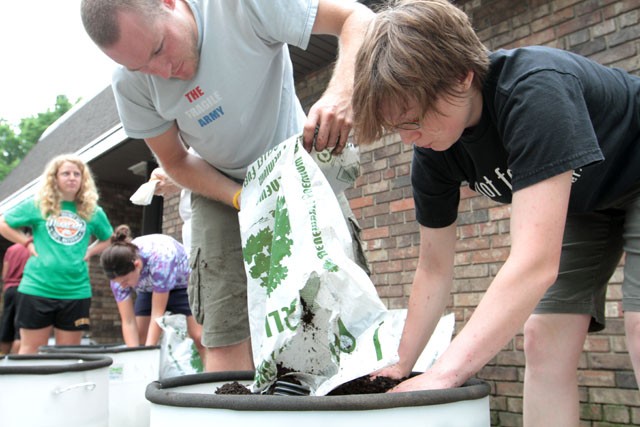Mallory Morken and Ellen Seltz slowly burned holes in plastic bottles with a soldering iron Saturday morning âÄî the first of many steps involved in building GrowBarrels.
The Southeast Como Improvement Association is trying to bring sustainability to a neighborhood that is surrounded by industrial areas, railroads and highways. With GrowBarrels, its latest project, SECIA has introduced a new way for residents in the area to grow their own food without having to dig up their yard for a garden.
GrowBarrels are portable self-watering container gardens that can be placed anywhere there is sunlight.
Urban gardeners puncture plastic bottles with more than a dozen small holes and pack them in the bottom of a 55-gallon plastic barrel. Those bottles are covered in soil and the bottom of the barrel is filled with water. The bottles collect the excess water from the soil and slowly redistribute it.
âÄúYou can go on vacation for a week and not worry that your tomatoes are going to shrivel up and die,âÄù said Stephanie Hankerson, the community garden organizer with SECIA.
About 20 residents from Southeast Como attended a GrowBarrel workshop in Van Cleve Park on Saturday.
Morken, who just graduated from the University of Minnesota, and Seltz, who has one year left, are moving together into a new apartment soon.
âÄúItâÄôs a great thing itâÄôs portable,âÄù Morken said. âÄúWe want to grow our own food, but we donâÄôt have a yard.âÄù
The GrowBarrels were designed with the renting populace of Southeast Como in mind, Hankerson said, as it can be hard to convince a landlord to dig up part of the yard for a garden âÄî if residents are lucky enough to even have a yard.
If a landlord does allow installing a garden, Hankerson said most people move out in the middle of the growing season in September.
Hankerson called GrowBarrels a âÄúlocal food projectâÄù and said the barrels will improve access to locally-grown and healthy food.
âÄúThereâÄôs nothing more local than right outside your door,âÄù Hankerson said.
Jennifer Nicklay, a biology fifth-year at the University, demonstrated the assembly process for the crowd Saturday.
After the demonstration, Nicklay walked among the residents, answering questions and giving suggestions for perfecting their GrowBarrels.
Nicklay said she âÄújust sort of fell intoâÄù the GrowBarrels project when she started at SECIA. She has been working on the project since fall 2009, when she heard about SECIA from an adviser at the University.
When Nicklay joined the team, the basic design of the barrels had been figured out. Nicklay started researching the types of plants that would flourish in a container.
Nicklay also worked with Hankerson to figure out how to use more recycled materials and make the barrels easier to assemble.
Saturday was SECIAâÄôs fourth GrowBarrels workshop. The group has hosted about 60 participants so far. Interest in the project has grown so much that SECIA had to set up a waitlist for Saturday.
SECIA was able to provide all the items necessary for assembling a GrowBarrel as well as the soil, plants, seeds, a growing schedule and a planting schematic thanks to a grant from the McKnight Foundation.
Hankerson said SECIA is interested in holding more workshops throughout the summer, and may even hold one at the annual Como Cookout on Sept. 18 in an attempt to get more students involved in the project.
âÄúItâÄôs been hard to match interest with the studentsâÄô spring schedules,âÄù Hankerson said.
For Rebekah Holmes, a recent graduate from Macalester College, a GrowBarrel is a great way to supplement her existing garden.
Holmes said she was able to âÄúwheel-and-dealâÄù with her landlord, and planted a garden at the home she is renting in Southeast Como.
Nicklay said GrowBarrels are a versatile way for homeowners to add on to their existing gardens. Residents can put the barrels in places where plants normally canâÄôt grow, like on the sidewalk or a porch.








